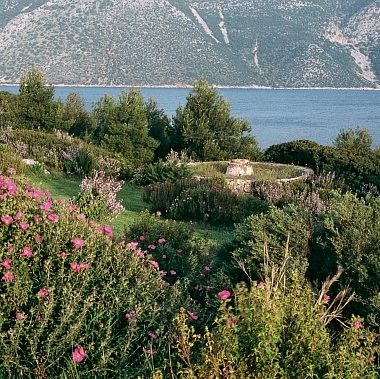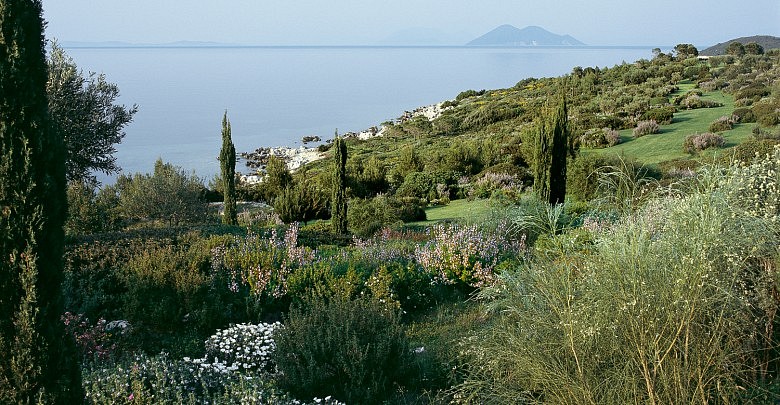Ecological notes
Taking into account the existing environment
Carving the site’s lentisks into cushions, preserving nearly one hectare of cistus sculpted by the sea spray, in large part respecting the topography, these are examples of minimal intervention for a maximum effect. In collaboration with John Harrison, manager of the property, we made use of the terrain’s materials to fashion the old-style dry-stone little walls and stairways. The choice of appropriate plants was of major importance. They were tested in the Mediterranean garden for their adaptability to the terrain’s different biotopes.
THE ECO-GESTURES
Circulation: building a shelter on the valley site to store the material and tools, because the old warehouse was located at the other end of the terrain, several kilometres away. We thus save time an energy.
Mulch: all the remains from clearing the undergrowth were ground up into mulch, thus avoiding evaporation and the growth of weeds on the plantations. We decided to spread it over the paths traced by the bulldozer so that new growths could sprout on the embankments.
SAVING WATER
On the model of the ancient cisterns present on the terrain, John created as soon as he arrived two large reservoirs capturing the water from the roofs and the gullies of the paths higher up. As these cisterns were elevated on the site, irrigation operated by gravity.
To reduce sprinkling to a minimum, different circuits were created adapted to the water-needs of the plants and the terrain’s different biotopes.
 The ancient water-cistern among the Aleppo pines.
The ancient water-cistern among the Aleppo pines.Natural vegetation: cistus, sage and lentisks.[/caption]
The plants were irrigated during the first three years by gradually reducing the sprinkling so that they became autonomous. Even if an automatic system is installed, it is continually re-adapted according to the gardens’ needs and climatic vagaries. John and I proposed the choice of a meadow which would dry out in the summer and take on the beautiful golden colour of the cereals once cultivated on these islands. The choice made by the owner has been to provide reasonable sprinkling for a grass not overly demanding in water. Sprinkling is frequent but brief, because the roots are not deep.
The ancient water-cistern among the Aleppo pines. Natural vegetation: cistus, sage and lentisks.
 2001: location photos revealing the site overlooking the sea. The natural vegetation will be preserved: cistus (rockrose), lentisks, carob trees. The work-site will aim mainly at creating an empty space in the middle of the area to convey and detach the vegetation on grass.[/caption]
2001: location photos revealing the site overlooking the sea. The natural vegetation will be preserved: cistus (rockrose), lentisks, carob trees. The work-site will aim mainly at creating an empty space in the middle of the area to convey and detach the vegetation on grass.[/caption]

 Work-site (2003): the path carved out by the bulldozer crosses the property over to the cape.[/caption]
Work-site (2003): the path carved out by the bulldozer crosses the property over to the cape.[/caption]
 The garden, conceived as a play of empty and occupied spaces, inserts itself naturally into the existing vegetation.[/caption]
The garden, conceived as a play of empty and occupied spaces, inserts itself naturally into the existing vegetation.[/caption]